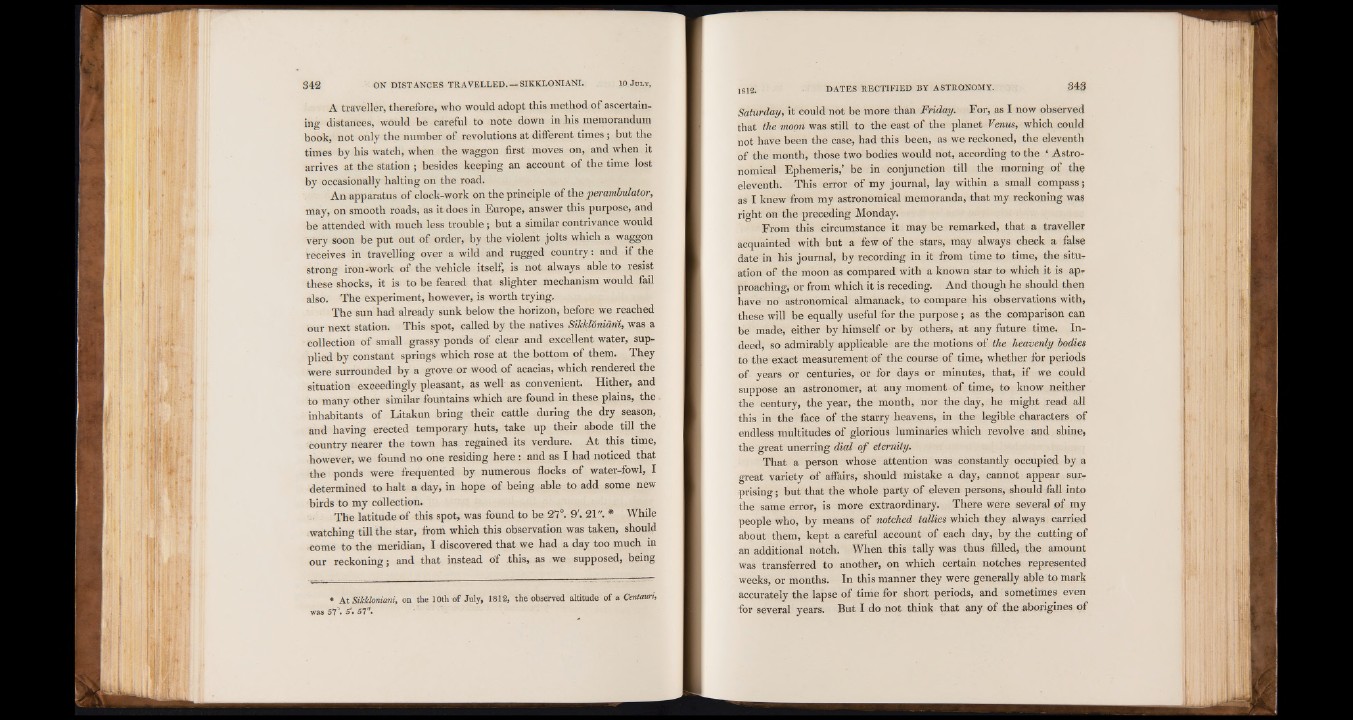
A traveller, therefore, who would adopt this method of ascertaining
distances, would be careful to note down in his memorandum
book, not only the number of revolutions at different times ; but the
times by his watch, when the waggon first moves on, and when it
arrives at the station ; besides keeping an account of the time lost
by occasionally halting on the road.
An apparatus of clock-work on the principle of the perambulator,
may, on smooth roads, as it does in Europe, answer this purpose, and
be attended with much less trouble ; but a similar contrivance would
very soon be put out of order, by the violent jolts which a waggon
receives in travelling over a wild and rugged country: and if the
strong iron-work of the vehicle itself, is not always able to resist
these shocks, it is to be feared that slighter mechanism would fail
also. The experiment, however, is worth trying.
The sun had already sunk below the horizon, before we reached
our next station. This spot, called by the natives Silcklbnidm, was a
collection of small grassy ponds of clear and excellent water, supplied
by constant springs which rose at the bottom of them. They
were surrounded by a grove or wood of acacias, which rendered the
situation exceedingly pleasant, as well as convenient. Hither, and
to many other similar fountains which are found in these plains, the
inhabitants of Litakun bring their cattle during the dry season,
and having erected temporary huts, take up their abode till the
country nearer the town has regained its verdure. At this time,
however, we found no one residing here : and as I had noticed that
the ponds were frequented by numerous flocks of water-fowl, I
determined to halt a day, in hope of being able to add some new
birds to my collection.
The latitude of this spot, was found to be 27°. 9'. 21". * While
watching till the star, from which this observation was taken, should
come to the meridian, I discovered that we had a day too much in
our reckoning; and that instead of .this, as we supposed, being
» At Sikkloniani, on the 10th-of July, 1812, the observed altitude of « Centaun,
was 57°. &'• 57".
Saturday, it could not be more than Friday. For, as I now observed
that the moon was still to the east of the planet Venus, which could
not have been the case, had this been, as we reckoned, the eleventh
of the month, those two bodies would not, according to the ‘ Astronomical
Ephemeris,’ be in conjunction till the morning of the
eleventh. This error of my journal, lay within a small compass;
as I knew from my astronomical memoranda, that my reckoning was
right on the preceding Monday.
From this circumstance it may be remarked, that a traveller
acquainted with but a few of the stars, may always check a false
date in his journal, by recording in it from time to time, the situation
of the moon as compared with a known star to which it is approaching,
or from which it is receding. And though he should then
have no astronomical almanack, to compare his observations with,
these will be equally useful for the purpose; as the comparison can
be made, either by himself or by others, at any future time. Indeed,
so admirably applicable are the motions of the heaverdy bodies
to the exact measurement of the course of time, whether for periods
of years or centuries, or for days or minutes, that, if we could
suppose an astronomer, at any moment of time, to know neither
the century, the year, the month, nor the day, he might read all
this in the face of the starry heavens, in the legible characters of
endless multitudes of glorious luminaries which revolve and shine,
the great unerring dial of eternity.
That a person whose attention was constantly occupied by a
great variety of affairs, should mistake a day, cannot appear surprising
; but that the whole party of eleven persons, should fall into
the same error, is more extraordinary. There were several of my
people who, by means of notched tallies which they always carried
about them, kept a careful account of each day, by the cutting of
an additional notch. When this tally was thus filled, the amount
was transferred to another, on which certain notches represented
weeks, or months. In this manner they were generally able to mark
accurately the lapse of time for short periods, and sometimes even
for several years. But I do not think that any of the aborigines of